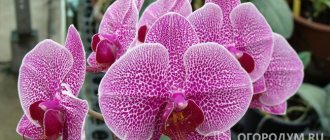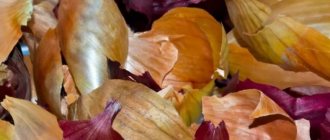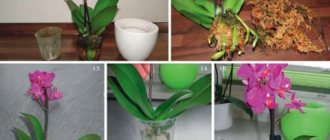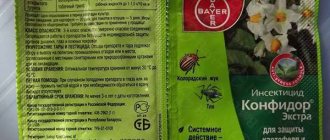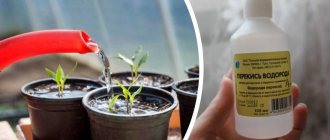In the natural environment, orchids grow either on the moist, rocky soil of tropical forests or on tree trunks, attached to cracks in the bark and forks of branches. Like all epiphytes, it receives nutrition directly from the air and moisture that falls as precipitation, as well as through photosynthesis. However, our window sills can hardly be compared with natural forests and fresh tropical showers, rich in microelements and vitamins. Therefore, any gardener should be able to choose the right fertilizer for orchids, especially during the period when flower stalks appear, buds are laid and the plant begins to bloom beautiful extraterrestrial flowers.
General requirements for fertilizers for orchids
The main thing that a novice orchid lover should firmly remember is that epiphytes really do not like overfeeding. Standard complexes for decorative flowering indoor plants are not suitable for them. Such fertilizers are too concentrated, and attempts to “manually” reduce the concentration by doubling or tripling the dilution are not always successful.
The second distinctive feature of orchid nutrition is its low nitrogen requirement. Essentially, if
Fertilizer for orchids: reviews, application. Only healthy orchids can be fertilized. It is very difficult for sick specimens or plants that have recently experienced stress (pruning, moving, infection, pest attack) to absorb fertilizing
plants grow well, they only need maintenance doses of this element. It is possible to increase its content in fertilizing only if leaf growth is clearly inhibited or clear signs of nitrogen deficiency appear.
Unlike fertilizers for other indoor plants, complexes for orchids should contain mainly phosphorus and potassium. But the concentration of these nutrients in them is low. In nature, most orchids grow without soil, clinging to a tree trunk, and some species are even lithophytes - that is, they are attached to stones. Under such conditions, they receive a meager amount of mineral nutrition, and their roots are physiologically unable to absorb large amounts of salts. This must be taken into account when choosing fertilizer.
Important! To feed orchid plants, it is better to choose only specialized fertilizers marked “For orchids”. Even professionals in the field of epiphyte breeding do not like to use universal complexes and even less often experiment with individual salts (urea, superphosphate, etc.). There is no practical need for this, since the choice of ready-made fertilizers for orchids is now quite wide.
Types of fertilizers for orchids: mineral and organomineral
Ready-made fertilizers for orchids are divided into two large groups - mineral and organomineral:
| Fertilizer group | Characteristic | Advantages and disadvantages |
| Mineral | Contain pure mineral compounds consisting of macro- and microelements in the form of salts or acids. | The advantage is simplicity and versatility of use (watering, immersion, spraying). Disadvantage: high risk of overdose if diluted incorrectly |
| Organomineral | They contain microelements in chelated form, often containing vitamins, amino acids, and phytohormones in the formula. | Advantages: higher bioavailability of nutrients and overall effectiveness. Disadvantage: risk of overdose. |
The forms of release of fertilizers for orchids can be as follows:
- liquid concentrates in bottles or ampoules;
- ready-made working solutions in sprays;
- prolonged liquid concentrates in applicators.
The cheapest and most popular options are concentrated solutions in bottles. Sprays and applicators are much more expensive, although they are very convenient to use.
Tip #1. Sometimes you can find fertilizers for orchids on sale in the form of sticks. But practice shows that this is a bad choice. In substrates for epiphytes, which must be dried quickly and completely, the sticks disperse poorly and interfere more with the roots. Moreover, they are not suitable for orchids that are grown without a substrate.
Eating methods
Phalaenopsis absorbs nutrition equally well both by root and foliar methods. If the root system is affected by rot, then they switch to spraying nutrients on the leaves.
Features of foliar feeding
There is a special fertilizer for sale for phalaenopsis orchids for flowering at home - “Doctor Foley - Orchid” with a sprayer. It is intended for foliar spraying. In this case, you need to make sure that the solution does not get on the buds and flowers if they have already formed.
Spraying is carried out in a dark place so that the plant does not receive direct sunlight. A draft is also harmful, and in a cold room the leaves will not absorb the solution.
Root nutrition of orchids
It is better to fertilize orchids with special means, but if there are none, then fertilizers for flowering plants are diluted 2-3 times and applied to the roots.
How to feed an orchid at home:
- Before immersing in the nutrient solution, the plant is immersed in clean, warm water so that the root system is not damaged by fertilizers.
- After 30 minutes, the roots are dipped into the prepared liquid solution and after 20 minutes they are put in place.
There must be no water or fertilizer left in the pan below. This promotes rotting of the root tips.
Comparative composition of some fertilizers for orchids
Ready-made complexes for orchids may have different ratios of the main nutrients - nitrogen, phosphorus and potassium. Depending on the proportion of these components, the purpose of the fertilizer changes:
| Fertilizer name | NPK proportions | Purpose |
| "Agricola for orchids" | 4:5:6 | For flowering |
| "Bona Forte for orchids" | 4:2,5:7 | To strengthen immunity and root growth |
| "Fasco for orchids" | 3:3:3 | For leaf growth, flowering and overall health improvement |
| "Agrecol for orchids" | 5:5:5 | For leaf growth, flowering and overall health improvement |
| "Crystal for orchids" | 3,8:3,8:4 | For leaf growth, flowering and overall health improvement |
Based on this table, orchid lovers can understand the basic principle by which they need to choose fertilizers. If the composition is low in nitrogen, but high in phosphorus and potassium, the complex is suitable for feeding orchids before flowering and for prolonging it. If the three main components are approximately equal - for feeding at the start of the growing season, during the growth of leaves. With an emphasis on potassium - to increase resistance to adverse factors and for the growth of the root system.
Types of fertilizing
They are divided into groups depending on their consistency. The following types are distinguished.
Concentrated
Usually it is double superphosphate. This fertilizer is prepared by decomposing natural phosphates of phosphoric acid. Such preparations are suitable for both root and foliar application. However, to achieve maximum results, flower growers advise using these products in tandem.
In sticks
Such fertilizers are characterized by a careful selection of nutrients. Typically, such fertilizing is used to prolong flowering and make it more lush. Fertilizers are applied in sticks during active plant growth .
The number of sticks depends on the diameter of the pot. The larger the container, the more fertilizer. These sticks are simply inserted into the soil, and be sure to water it. Fertilizers need to be changed every three months.
Liquid
These fertilizers are the most popular due to their ease of use and the absence of the risk of excess elements. Liquid fertilizers, in turn, are also divided into subtypes:
- Potash . They help improve the appearance of the orchid, activate its growth and lay buds.
- Phosphorous . Typically used to prolong flowering.
- Nitrogen . They improve the growth of the green part of the flower.
You will learn in this article about what fertilizers are needed for the plant to bloom and bear children, and read about what and how to fertilize an orchid during flowering here.
“Pokon for orchids”: description and instructions
In the TOP of the most popular complexes for feeding orchids is a product of the famous Dutch agrochemical. It belongs to classic mineral fertilizers and is produced in the form of a liquid concentrate, packaged in 250 ml bottles. The price per bottle is about 215 rubles.
In addition to the basic nutrients, this supplement contains the following minerals:
- boron;
- manganese;
- iron;
- zinc;
- copper;
- molybdenum. It is recommended to fertilize with Pokon fertilizer taking into account the season: in spring and summer – once a week, in winter – once every 2 weeks. For leaf spraying, you can prepare a less concentrated solution than for root spraying: 2.5 ml of concentrate per 1 liter of water
The NPK proportion in this complex is composed with an emphasis on potassium and phosphorus - 5:6:7. It contains nitrogen in three forms at once - nitrate, ammonium and amide. This allows you to apply “Pokon” both at the root and along the leaf. Fertilizer is diluted at the rate of 5 ml per 1 liter of water, so the bottle is enough to prepare 50 liters of working solution.
“I use almost nothing except Pocon, and my orchids are doing great. I don’t always adhere to the regimen that is written in the instructions; I feed intuitively when I feel it’s time. With this fertilizer, some phalaenopsis began to produce 2 flower stalks at a time. I don’t notice any shortcomings or side effects” (Marina, Volgograd).
Feeding products
To feed phalaenopsis orchids, it is better to use liquid products. In them, the amount of substances is dosed; there is no need to specifically measure the amount of granules or powder. It is advisable to use a chelated form with microelements. Calcium and iron are especially important.
Calcium maintains the required level of soil acidity. Too high or low pH leads to poor absorption of nutrients, since they are bound and do not enter the plant.
Organic fertilizers
Organic matter is needed to hold (fix) the plant in the pot. For this, tree bark or a light plant substrate is usually used, which allows air to pass through well and does not accumulate moisture.
The best fertilizer for feeding orchids is horse manure. It is dissolved in water, diluted and watered, making sure that the concentration of the solution is weak. Manure is useful during the period of foliage growth. It also contains the necessary substances to stimulate flowering - potassium and some phosphorus.
When fertilizing a phalaenopsis orchid with organic matter, it is better to use rotted manure with a low nitrogen concentration. The rule of flower growers that it is better to underfeed is very relevant for epiphytes.
Mineral supplements
In addition to the essentials - nitrogen, potassium and phosphorus - orchids need magnesium for the photosynthesis process, as well as iron, glucose, succinic acid, and B vitamins. The hormone cytokinin is used to accelerate cell division.
Potassium, calcium and phosphorus affect the color characteristics of epiphytic plants. With a lack of potassium and phosphorus, buds may not form, and nitrogen metabolism will be disrupted.
Since the nutrient content in the bark is extremely low, the main means of feeding an orchid at home are mineral fertilizers.
"Doctor Foley Orchid": composition features and reviews
One of the best fertilizers in spray form is “Doctor Foley Orchid” from the Ukrainian company “Gilea”. There is no need to dilute it in any way; the solution is completely ready for use. But orchid lovers fell in love with it not for this, but for its perfectly selected composition. In addition to the standard set of macro- and microelements that can be found in other complexes, Doctor Foley contains biologically active substances:
- amino acids – glycine, tryptophan, saponin, agrinin;
- vitamins – all group B and PP;
- phytohormones – gibberellins, auxin, cytokinin.
In essence, Doctor Foley Orchid is a fertilizer with powerful stimulating and revitalizing potential. But even on problem-free specimens it shows a good effect, increasing the quality and duration of flowering:
Sprays are used exclusively on leaves. It is impossible to spray the inflorescences with fertilizers, and the axils of the leaves after application should remain dry, without accumulating the drained solution.
“I really loved the Dr. Foley sprays. Some of my orchids sit on the north window, and they have an eternal problem with leaving dormancy and getting sores. I use it in turn, at the start - “Doctor Foley Starter”, and closer to flowering - “Doctor Foley Orchid”. I spray the leaves and all the roots that stick out from the pot. The condition is noticeably improving, flowering is normal” (Albina, Moscow).
Doctor Foley Starter fertilizer is not designed specifically for epiphytes; it can be used for any indoor flowers. But if the orchid “stays too long” and does not want to produce young leaves, its one-time use will not harm. The average cost of both formulations is 150 rubles per bottle.
Which ones are better and why?
Choosing the best drug is not an easy task. Each is effective in its own way. If you choose among homemade products, it is better to give preference to castor oil. Of the store-bought products, Zircon is the most popular. Its main advantage is the absence of toxic elements. It is considered a complex fertilizer, so with the help of Zircon you can solve several problems with an orchid.
You will find an overview of the most popular means for feeding, processing and successfully growing orchids on the pages of our website. Read about such drugs as: Fitoverm, Aktara, Epin, Bona Forte, Fitosporin, Cytokinin paste, succinic acid and vitamins.
Of course, fertilizing is intended to improve the condition of the plant. However, it will be possible to notice a positive effect only if used correctly, following the instructions exactly. If you overdo it with fertilizer, you can completely ruin the orchid.
“REASIL for orchids”: description, reviews and instructions
Of the organomineral complexes for orchids, experts most often recommend “REASIL” - an innovative chelate complex with very high resistance to sunlight. This feature sets it apart from other chelated fertilizers, which can quickly disintegrate in light. And since orchids have not only leaves under light, but also roots, this property can be considered a serious advantage.
The proportion of macroelements in the REASIL fertilizer for orchids is shifted towards potassium and balanced in nitrogen and phosphorus - 6:6:10. In addition to these main components, the composition contains the following:
- microelements in the form of chelates - iron, copper, boron, manganese, zinc, molybdenum, cobalt, calcium, magnesium;
- vitamins – C and group B;
- organic acids – succinic, citric;
- amino acids – L-lysine.
Judging by the reviews of plant growers, “REASIL for orchids” almost works wonders:
"REASIL" is one of the most economical fertilizers for orchids. A 250 ml bottle costs only 90-100 rubles. Taking into account the low consumption of concentrate when preparing the working solution, this container is enough for 250 liters of ready-made fertilizer
“In the summer they gave me a phalaenopsis, and it bloomed all summer. When the flowers began to fall in the fall, I decided to try feeding it so that it would continue to bloom. I bought “Reasil for orchids”, watered it and soon noticed that new flower buds began to grow at the tip of the peduncle. I started feeding her with Reasil once a month. After the top of the peduncle has bloomed, the lower side buds begin to grow. It turns out that my phalaenopsis is not going to retire yet” (Elena, Bryansk).
“REASIL for orchids” is available in the form of a liquid concentrate and is diluted 1 ml per 1 liter of water for root feeding. For leafy ones, the concentration is half as much, 1 ml per 2 liters of water. In spring and summer, orchids are fertilized with this solution once every 2 weeks, in autumn and winter - once a month.
Rules for feeding
When feeding orchids is contraindicated:
- during flowering;
- nitrogen fertilizers for orchids before the formation of buds - this stimulates leaf growth, but budding does not occur;
- if the plant is weakened, then the roots are cleaned of rot and allowed to dry, and minerals are applied in small doses to the leaves;
- During the dormant period - in winter - very little time is devoted to feeding orchids: once a month in a diluted concentration.
To prevent beginners from making mistakes and harming the plant, it is recommended to purchase special solutions in liquid form for each period of phalaenopsis growth. For example, “Doctor Foley” has two versions of its drug:
- for young plants that are just forming and growing leaves;
- for adults who are already starting to bloom.
Before purchasing, you need to read the instructions on why and when to feed the phalaenopsis orchid with this product, and whether it can be used during flowering.
Video: Feeding orchids
The problem of using organic fertilizers for orchids
Some manufacturers also produce organic fertilizers for orchids in the form of humates or vermicompost. Growers who are accustomed to crops growing in soil are very tempted to buy these complexes. However, it is better not to do this.
Indeed, vermicompost and various humates are an excellent and completely safe alternative to mineral fertilizers. But their task is to increase natural soil fertility. For epiphytes, this type of fertilizer is not only useless, but also harmful. The problem is that humic acids activate microflora, which decomposes organic residues. Therefore, the substrate for orchids under their influence very quickly turns into dust.
Expert advice on choosing fertilizer for orchids
When choosing fertilizer for their orchids, amateur plant growers can rely on the general recommendation given by experienced experts in this field:
“You don’t need to stock up on a lot of fertilizer. All you have to do is choose one. Let it be the simplest “Agricola for orchids” or some kind of chelate complex. Additionally, in the “orchid grower’s first aid kit” you can purchase succinic acid and a good resuscitator - for example, “Ribav-Extra”. This is quite enough for successful breeding of orchids.”
A. Davydovskaya, owner of the greenhouse

